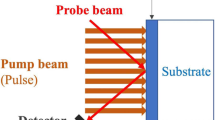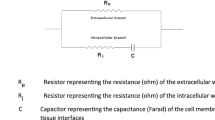Abstract
Overflow to non-target tissue during FNS can be reduced by controlling current density distribution under surface stimulating electrodes. A method is introduced for the acquisition of 3-D current density distributions under complex surface stimulating FNS electrode geometries. The method makes use of a phantom model in which a conventional homogeneous model has been improved by adding a layer to simulate skin impedance properties, based on specific FNS parameters. Signal acquisition and processing circuits have been developed to simulate the process by which excitable tissue responds to external stimulation. In addition, a data analysis method has been introduced to allow for the characterisation of stimulation current intensity, electrode geometry and pulse waveform required to achieve target muscle activation, with minimal overflow and to avoid pain or burning. Measurements of integrated differential voltage corresponding to current density distribution acquired under electrodes of various geometries are presented in terms of 3-D attenuation coefficient maps as examples of the applicability of the method.
Similar content being viewed by others
References
Berson, A. S., andPipburger, V. H. (1968): ‘Skin electrode impedance problems in electrocardiography’,Am. Heart J.,76, pp. 514–525
Brennen, K. R. (1976): ‘The characterization of transcutaneous stimulating electrodes’,IEEE Trans.,BME-33, pp. 337–340
Cilliers, P. J., andWeed, H. R. (1988). ‘The current density distribution of resistive disk surface electrodes.’ IEEE Engineering in Medicine and Biology Society 10th Annual International Conf., pp. 814–815
Debneth, N., Anand, S., andGhua, S. K. (1987): ‘Electrical current distribution analysis for FES of the paraplegic.’ IEEE 9th Annual Conf. of the Engineering in Medicine and Biology Society, pp. 2080–2081
Debneth, N., Anand, S. andGuha, S. K. (1988): ‘Current distribution and motor unit recruitment in multiplane FES.’ IEEE 10th Annual Conf. of the Engineering in Medicine and Biology Society, pp. 1743–1744
Ifukube, T., andWhite, R. L. (1987): ‘Current distributions produced inside and outside the cochlea from a scala-timpani electrode array’,IEEE Trans.,BME-34, pp. 883–890
Kim, Y., Ziener, H. G., andWang F. E. (1990): ‘Uniformity of current density under stimulating electrodes’,Crit. Rev. Biomed. Eng.,17, pp. 585–619.
Kinnen, E. (1965): ‘Electrical impedance of human skin,’Med. Electron Biol. Eng.,3, pp. 67–70.
Nathan, R. H. (1990): ‘FNS of the upper limb: Targeting the forearm muscles for surface stimulation’,Med. Biol. Eng. Comput.,28, pp. 249–256
Nathan, R. H., andOhry, A. (1990): ‘Upper limb functions regained in the C4 quadriplegic: a hybrid computerized neuromuscular stimulating system’,Arch. Phys. Med. Rehabil.,71, pp. 415–421
Ratty, F. (1986): ‘Analysis of models for esternal stimulation of axons’,IEEE Trans. BME-33, pp. 974–977
Ratty, F. (1986): ‘Ways to approximate the current-distance relations for electrically stimulated fibers’,J. Th. Biol.,125, pp. 339–349
Ratty, F. (1988): ‘Modeling the excitation of fibers under surface electrodes’,IEEE Trans.,BME-35, pp. 199–202
Reddy, C. M., andWebster, J. G. (1984): ‘Uniform current density electrodes for transcutaneous nerve stimulation.’ IEEE Frontiers of Engineering and Computing in Health Care, pp. 187–190
Rosell, J., Colominas, J., Riu, P., Pallas-Areney, R., andWebster, J. G. (1988): ‘Skin impedance from 1 Hz to 1 MHz,’IEEE Trans.,BME-35, pp. 649–651
Swanson, D. K. andWebster, J. G. (1974): ‘A model for skin electrode impedance’in:Miller, H. A., andHarrison, D. C. (Eds.), ‘Biomedical electrode technology’ (Academic Press, New York) pp. 117–128
Wiley, J. D., andWebster, J. G. (1982a). ‘Analysis and control of the current distribution under circular dispersive electrodes’,IEEE Trans.,BME-29, pp. 381–385
Wiley, J. D., andWebster, J. G. (1982b): ‘Distributed equivalent models for circular dispersive electrodes’,IEEE Trans.,BME-29, pp. 385–389
Author information
Authors and Affiliations
Rights and permissions
About this article
Cite this article
Sagi-Dolev, A.M., Prutchi, D. & Nathan, R.H. Three-dimensional current density distribution under surface stimulation electrodes. Med. Biol. Eng. Comput. 33, 403–408 (1995). https://doi.org/10.1007/BF02510523
Received:
Accepted:
Issue Date:
DOI: https://doi.org/10.1007/BF02510523




